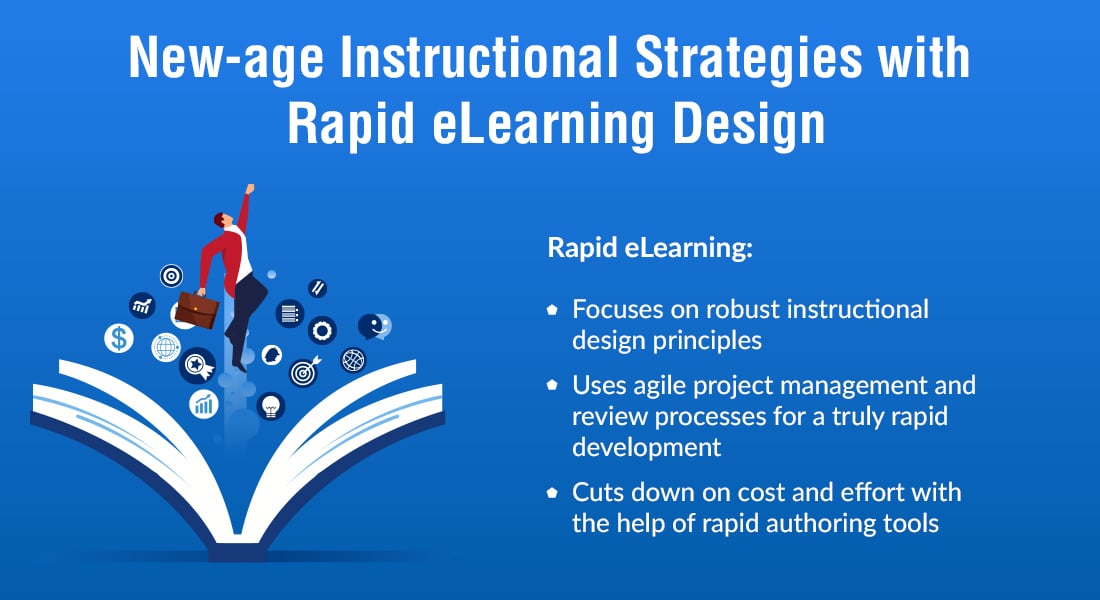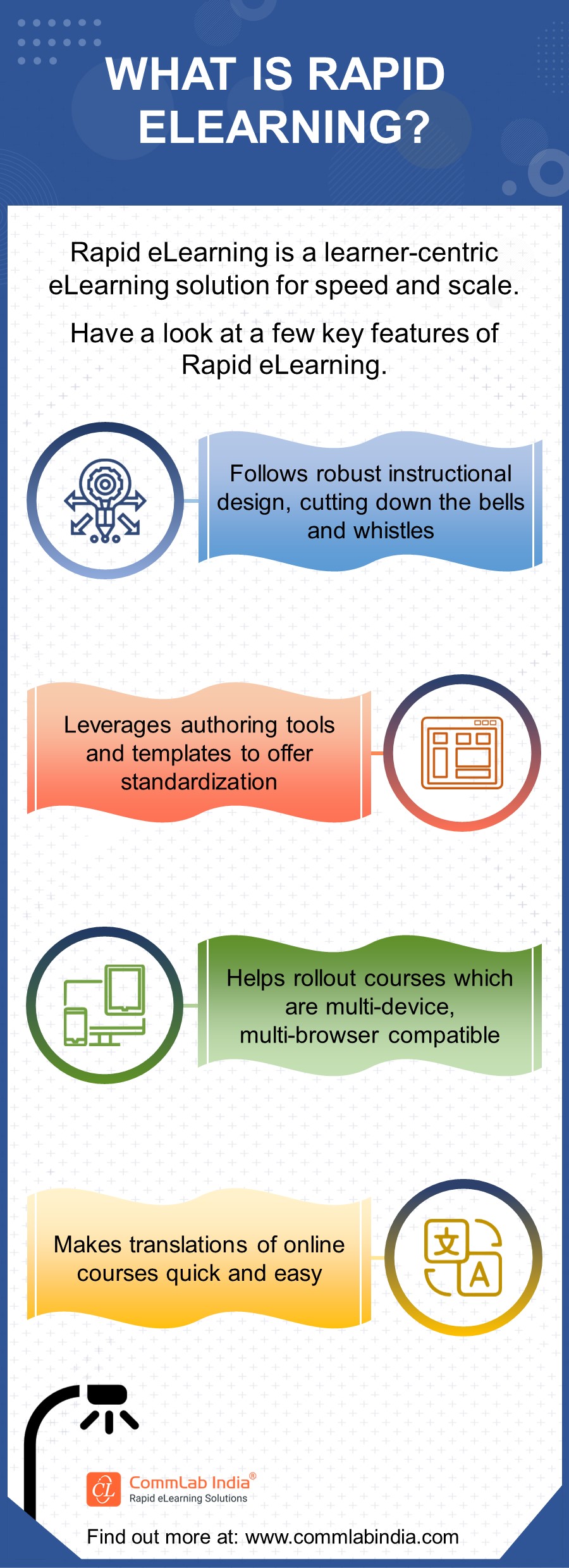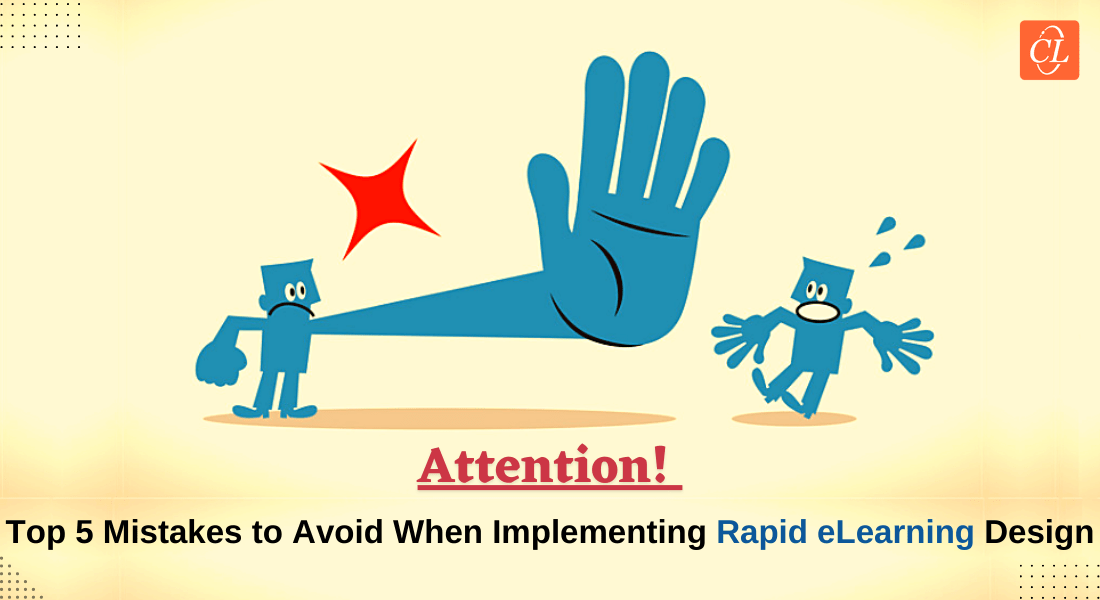Implement New-age Instructional Strategies with Rapid eLearning Design

What would you do if you’re shown a way to make learning experiences effective, engaging, fun, and memorable for your learners? Wouldn’t you jump at it? So, what’s stopping you from adopting new-age instructional strategies like simulations, scenarios, and game-based designs? Oh, that’s right, issues with budget, timelines, and technical expertise! What if I told you there was a way to include new-age instructional strategies without going over the top with any of these? Don’t believe me? Well…you should try Rapid eLearning design.
Why Use Rapid eLearning Design for Implementing New-age Instructional Strategy
- Bases Instruction on Robust Instructional Design Principles
- Uses Agile and Iterative Project Management and Review Processes
- Leverages the Super Powers of Rapid eLearning Authoring Tools
Check out our free webinar on new-age instructional strategies to improve knowledge retention.
What is Rapid eLearning Design?
Rapid eLearning design is a set of processes put in place to cut down on the time to design eLearning courses by leveraging the benefits of robust instructional design principles, efficient project management, and the technology of authoring tools.
You may be thinking, “Our good old slide-based eLearning courses are good enough, so why go through all this hassle of adopting new-age instructional design strategies?” But the truth is, new-age learning instructional strategies have become a decisive factor in how successful your training program is going to be. Here are a few reasons:
- New-age instructional strategies help you create more impactful learning experiences. When learning is more interactive and impactful, learners absorb knowledge faster and also retain that knowledge better.
- New-age instructional strategies appeal to the young millennial and Gen Z learners who now form a major part of the workforce. It gives them an edutaining learning experience, hooks their attention (believe me, a very difficult task!), and keeps them engaged throughout the duration of training.
- New-age instructional strategies like simulations and scenarios prepare learners to perform their job tasks effectively. Simulations help learners familiarize themselves with the actual job environment and scenarios help in critical thinking and decision making.
So now that you understand the appeal and importance of new-age instructional design strategies, are you ready to find out how rapid eLearning design can help you create those amazing learning experiences?
How Rapid eLearning Design Can Help Implement New-age Instructional Strategies
1. Bases Instruction on Robust Instructional Design Principles
Rapid eLearning design does away with the extraneous media elements and irrelevant interactivities that are a part of conventional eLearning courses. The focus is primarily on robust instructional design principles. This includes setting relevant performance-based learning objectives that are aligned with the organization’s business goals. These performance-based learning objectives, in turn, determine all aspects of eLearning design – the scope of content, instructional design strategy, assessments, cost, and duration of training.
With performance-based learning objectives in place, you can easily decide what new-age instructional strategy you are going to use. If the learning objective falls under the ‘understanding’ level of Bloom’s Taxonomy, it can be a straightforward eLearning, maybe with simple scenarios or storytelling. If the learning objective calls for learners to apply their knowledge, simulations and game-based instructional design can be used. If the learning objective is for learners to analyze a given situation and resolve it, they can benefit from branching scenarios.
2. Uses Agile and Iterative Project Management and Review Processes
An agile and iterative process is used in rapid eLearning design for the planning, design, development, and review phases. This saves a lot of time that would otherwise have been wasted on rework. All decisions related to the course are made keeping the stakeholders and SMEs in the loop. The process does not go forward unless the stakeholders approve the previous step – this ensures each stage is signed off, leaving no room for huge amounts of feedback at the end of the process. All elements (templates, GUI, images, etc.) can be approved and standardized right at the start so you don’t have to keep going back for approvals over and over again. Also, with a standardized process in place, there are fewer margins for error and more chances for a quality eLearning course.
3. Leverages the Super Powers of Rapid eLearning Authoring Tools
Authoring tools are the most powerful weapons in rapid eLearning design that can help you win against issues with time, cost, and quality.
First, authoring tools come with built-in templates, media assets, and interactivities. That means even if you are planning to use a highly interactive instructional strategy (maybe simulations or branching scenarios, or a combination of the two), you can make it happen without much programming effort, with no compromise on quality, and within the assigned budget and timeline.
Second, even if you are going for an instructional strategy that requires high-tech applications like VR, authoring tools such as Adobe Captivate and Lectora CenarioVR can enable rapid eLearning design here too with their VR-based templates.
Third, with authoring tools, you have the luxury of using their online review tools that allow you to streamline the review-feedback implementation loop, save SME’s time, and help maintain the quality of the course.
Summing it Up!
See how easily you can implement new-age instructional strategies using rapid eLearning design? This way not only do you get your eLearning solutions at the speed of need but also can keep up with your organization’s changing training requirements.
For more information on rapid eLearning design, download our free eBook.
Editor’s note: This post was originally published in November 2020 and has been updated for comprehensiveness.






